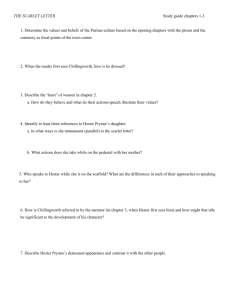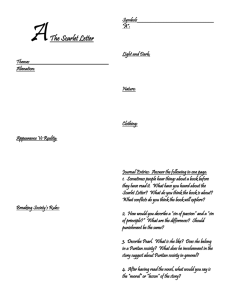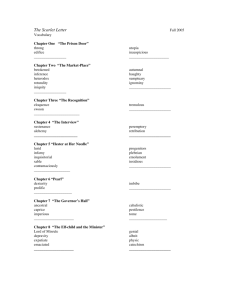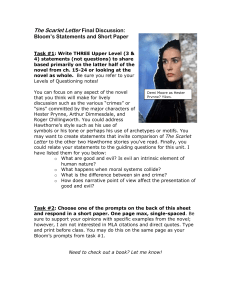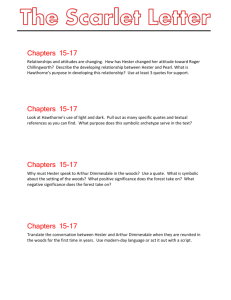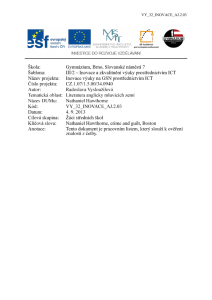Requisite material Hester Prynne and the Virgin
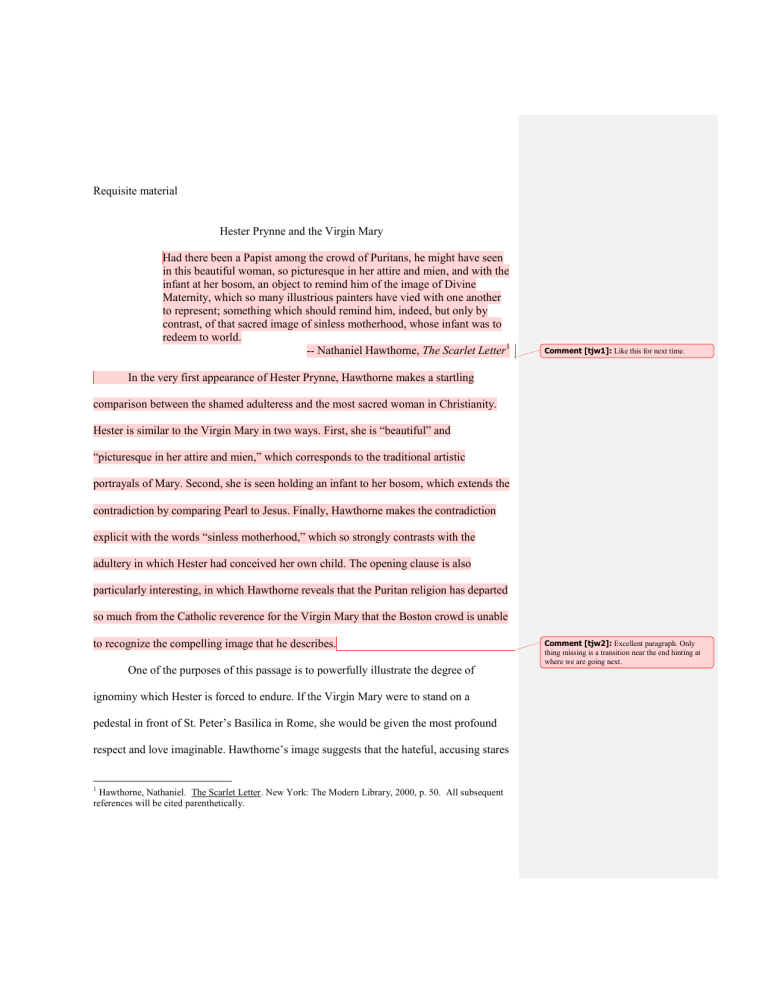
Requisite material
Hester Prynne and the Virgin Mary
Had there been a Papist among the crowd of Puritans, he might have seen in this beautiful woman, so picturesque in her attire and mien, and with the infant at her bosom, an object to remind him of the image of Divine
Maternity, which so many illustrious painters have vied with one another to represent; something which should remind him, indeed, but only by contrast, of that sacred image of sinless motherhood, whose infant was to redeem to world.
-- Nathaniel Hawthorne, The Scarlet Letter
1
In the very first appearance of Hester Prynne, Hawthorne makes a startling comparison between the shamed adulteress and the most sacred woman in Christianity.
Hester is similar to the Virgin Mary in two ways. First, she is “beautiful” and
“picturesque in her attire and mien,” which corresponds to the traditional artistic portrayals of Mary. Second, she is seen holding an infant to her bosom, which extends the contradiction by comparing Pearl to Jesus. Finally, Hawthorne makes the contradiction explicit with the words “sinless motherhood,” which so strongly contrasts with the adultery in which Hester had conceived her own child. The opening clause is also particularly interesting, in which Hawthorne reveals that the Puritan religion has departed so much from the Catholic reverence for the Virgin Mary that the Boston crowd is unable to recognize the compelling image that he describes.
One of the purposes of this passage is to powerfully illustrate the degree of ignominy which Hester is forced to endure. If the Virgin Mary were to stand on a pedestal in front of St. Peter’s Basilica in Rome, she would be given the most profound respect and love imaginable. Hawthorne’s image suggests that the hateful, accusing stares
1
Hawthorne, Nathaniel. The Scarlet Letter. New York: The Modern Library, 2000, p. 50. All subsequent references will be cited parenthetically.
Comment [tjw1]:
Like this for next time.
Comment [tjw2]:
Excellent paragraph. Only thing missing is a transition near the end hinting at where we are going next.
Last.Name / 2 focused on Hester are fully as passionate as the respectful, loving stares would be at this imaginary Marian appearance in Rome.
The passage also serves to impart an understanding of Hester’s dignity and pride in the face of tremendous shame. Despite the horrible punishment, which “was almost intolerable to be borne…she had fortified herself to encounter the stings and venomous stabs of public contumely” (51). Hawthorne uses the image of the Virgin Mary to illustrate, quite effectively, that despite almost overwhelming impulses to “cast herself from the scaffold down upon the ground, or else go mad at once” (51), Hester manages to master her own demeanor sufficiently to warrant a comparison with the Christian ideal of feminine virtue.
These two ideas contained in the quoted passage hint at something that will persist throughout the novel. First, Hester’s exclusion from the community will be as great as this passage suggests. Second, her strength will indeed be sufficient for her to maintain her dignity throughout her life, and even gain some measure of respect. But the contrast with Mary is never erased, and her tombstone serves as a warning to any woman who might wish to follow in her footsteps.
You have the idea of these papers down. Keep it up, as with practice you will be able to get into more interesting and complex areas. So that’s no problem. My only issue with this paper is that it seems to me like you backed away from really confronting the complexity of this comparison. The symbol of adultery is compared with the symbol of virgin purity. That is MAJOR, but I don’t think your treatment acknowledges it. As the
Comment [tjw3]:
Yes, Mary is the ideal of feminine virtue, but as a VIRGIN. Mary is representative of accepting God’s plan, although I don’t think she is often associated with fortitude against adversity. Except maybe as Our Lady of
Guadelupe… I don’t know. Mary seems more like inspiration to get through trouble, rather than representative of behavior when in trouble. This paragraph seems tenuous.
Comment [tjw4]:
Not sure I follow this part.
What is the effect of the Mary comparison?
Last.Name / 3 sin seems to be the central distinction between Mary and Hester, what does this comparison say about sin? What statement does the book itself make about sin? Its tough, for sure, but that’s where the real meat is. Sink your teeth in!
